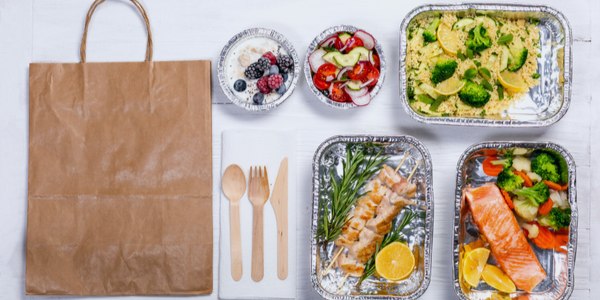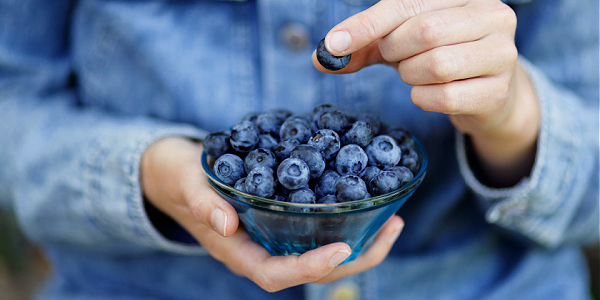
Finding the best frozen food for weight loss among the aisles can seem tricky at first. Luckily, a list of nutritious and delicious freezer foods can help you make the right choice for your lifestyle.
When on a weight loss journey, convenient staples and diligent label-reading can help you reach your goals. Find the top 20 freezer foods list ahead, including expert-approved picks you can stock up on today.
How to Find the Best Frozen Food for Weight Loss & Health
The freezer isn’t just for ice cubes and ice cube trays. Freezer meals can be a source of convenient, comfort food while also helping you lose weight. Contrary to popular myths, frozen foods can be both delicious and nutritious.
Finding the best freezer foods for weight loss starts by looking at the label. When shopping at the grocery store, steering clear of added sugars and salt can help contribute to a healthy lifestyle. Look for unsweetened or “low sodium” varieties of frozen foods to help you eat healthily.
When searching for satiating foods, it’s important to seek out healthy fats, high fiber, and lean protein. These nutrients help keep you feeling full, even when you’re trying to lose weight. Ingredients like olive oil can make frozen foods more satisfying.
If you are freezing foods that are homemade, be mindful of portion control. Homemade baked goods, like banana bread or muffins, can easily be frozen in single slices or servings. This makes for pre-portioned healthy snacks and easy on-the-go eating.
Healthy Freezer Foods List
Stocking your freezer with healthy food options? Support your weight loss journey with the following foods.
Breakfast Burritos
Frozen burritos often get a bad rap. As long as you keep an eye on sodium and serving sizes, breakfast burritos from the freezer can be an easy and accessible breakfast.
When looking for pre-packaged burritos, be sure to check the ingredients list. When losing weight, lean proteins like chicken, turkey, or eggs are best (as opposed to more processed meats like bacon). Plant-based proteins, such as beans and vegetables, can add flavor to your burritos while also bulking them up.
Sliced Bananas
Bananas are one of the most versatile ingredients to keep stashed in your freezer. Freezing ripe bananas ensures a natural sweetness can be added to recipes at a moment’s notice. Bananas can be used from breakfast to dessert, adding dimension to smoothies and “nice” cream.
Unsweetened Berries
Since fresh berries can be pricey, keeping a frozen mix in your freezer is a smart move. In fact, frozen varieties of berries can be up to half the price of their fresh counterparts.
Instead of letting fresh berries go bad in the back of your fridge, keep a bag of berries (picked at the peak of ripeness) in the front of your freezer. They can be easily added to smoothies, parfaits, baked goods, homemade sorbets, and much more.
Unsweetened Mango
Tropical fruits, like mango, often travel a long way before you buy them fresh. Luckily, frozen options are available. Like frozen berries, mangos are often selected and frozen at peak freshness.
Frozen mango is especially versatile because it can be used in both sweet and savory dishes. Mango tastes great in smoothies, but can also be defrosted and added to last-minute salsas, enchiladas, curries, and wraps.
Spinach
Spinach is one of the most versatile freezer ingredients. It can be added to slow-cooker meals, casseroles, and more. This leafy green is also perfect for premade smoothie kits to keep you going on busy mornings.
Well-suited for weight loss, a cup of spinach contains about 7 calories. It’s also incredibly affordable, with a 12 oz bag costing as little as $1.00-$1.50.
Ground Meat
Ground meats, like ground beef, are actually considered a type of lean protein. Beyond being versatile, ground meats are generally less expensive than other cuts. While some stores sell 1 lb portion sizes (which are perfect for family meals), you can also buy bigger packages to divide into smaller portions before freezing.
Turkey, chicken, beef, and pork are popular ground meats. They can easily be frozen and turned into last-minute meal components like meatballs or burgers.
Fish Filets
If finding single serving filets is difficult, try buying options like salmon on sale then slicing them into single portions before freezing. From afternoon salads to last minute dinners, seafood makes a great addition to many meals. Plus, the average 3 oz filet can contain almost 20 grams of protein.
Minced Garlic
Garlic is a crucial flavoring agent in many recipes, and is also heralded for its health benefits. When looking to lose weight, becoming familiar with seasonings other than salt can improve overall health and help with conditions like hypertension.
Frozen garlic is affordable, with options generally ranging from $3.00-$5.00. Plus, frozen cubes make it easy to add the same amount to recipes each time. Many forms of frozen garlic are available and you can freeze leftover garlic from the grocery store in many forms, including:
• Crushed garlic cubes
• Chopped or minced garlic
• Pureed garlic
• Roasted cloves
• Whole raw cloves
Minced Ginger
Ginger is another versatile, flavorful spice that researchers have linked with weight loss benefits. It’s featured prominently in many types of cuisines, including Chinese, Thai, Korean, Indian, and more. It can also be incorporated into almost any meal, from morning juices and teas to dinnertime soups and stir-fries.
Similar to frozen garlic, ginger is affordable and available in many forms. Among the supermarket aisles, look for crushed ginger cubes. If you’re working with ginger root at home, it can be frozen whole, in pieces, or pureed.
Broth
Broth is a common ingredient in many dinner recipes. However, it is relatively perishable, with most brands recommending use within 5-7 days after opening. Easily freeze broth in an empty ice cube tray so it is ready for adding to recipes at a moment’s notice.
Frozen broth, scraps and all, maintains many nutrients. Although frozen, it can add a fresh take to basics like rice or pasta.
Soups and Stews
Although somewhat surprising, soups, stews, and chilis freeze well. They can be batch-cooked and frozen for a rainy day, or can be safely stored in the freezer as leftovers.
Using small, airtight containers, you can save single servings for an easy lunch or dinner. Soups and stews are also great for supporting weight loss during times of recovery, especially when you don’t have the time or ability to make meals.
Cauliflower Rice
Riced cauliflower is a low-carb, low-calorie alternative to rice. It can transfer from the freezer to the microwave to a plate within minutes.
Another perk of cauliflower rice is that it can be store-bought or homemade. Simply slice and dice a whole head of cauliflower and use a food processor for the homemade variety. Alternatively, look for store-bought freezer packages with no added salt.
Whole Wheats and Grains
Many whole wheats and grains can be frozen for later use. The following foods can be frozen and defrosted at a later date:
• Bread
• Breadcrumbs
• Tortillas
• Pizza crusts
• Wraps
Don’t forget that doughs, such as whole-wheat dough for dinner rolls, can also be frozen.
Quinoa Bowls
Quinoa bowls are also a great option when it comes to freezer meals. Mixing quinoa with vegetables and seasonings can make a filling and delicious dish. As with other freezer foods, it’s important to seal the meal in an airtight container.
Store-bought options are becoming more popular and accessible, with frozen bowls generally costing $5.00 or under. Alternatively, you can freeze protein-packed casseroles like cheesy quinoa.
Stir-Fry Medley
Stir-fry vegetable medleys are essentially a “just add protein” meal, making family dinner an easy affair on busy weeknights. Like frozen fruits, frozen vegetables are typically frozen at peak freshness (which means nutrients are preserved).
Look on the label for vegetable mixes that have low (or no) sodium. In general, it’s also best to steer clear of store-bought sauces and dips since they can add more calories and work against your weight loss goals.
Low Sodium Vegetables
Speaking of frozen vegetables, almost any variety makes a great side dish in a pinch. Popular picks include:
• Carrots
• Corn
• Mushrooms
• Peas
Be sure to check that your chosen veggie (or veggie medley) is low-sodium. Once defrosted, you can add some oil, a small amount of butter, or herbs for flavor.
Legumes and Bean-Based Meals
Legumes and beans often have a higher protein and fiber content, which can make an otherwise boring meal feel more filling. Most beans can be drained, rinsed, and then frozen in freezer bags for weight loss-friendly meals. As with most savory freezer foods, look for low levels of salt (or no added sodium at all).
Edamame is the perfect example of a food that can be eaten on its own or enjoyed as part of a plant-based dish. Plus, edamame provides 8 grams of fiber and can be quickly cooked.
Nuts & Nut Flours
Like legumes, nuts can also be frozen. Freezing nuts has an added benefit, since the freezing process helps preserve the healthy fats in nuts before they go rancid.
Nuts can be purchased in bulk from the store, and then frozen in common serving sizes or recipe portions (i.e. ¼ cup). For weight loss-friendly meals, keep the following shelled or unshelled varieties on hand:
• Almonds
• Cashews
• Hazelnuts
• Peanuts
• Pistachios
• Walnuts
Surprisingly, nut flours can also be frozen if you don’t use the full amount at once.
Mediterranean-Style Meals
Since a Mediterranean diet is plant-based, it’s often recommended for weight loss and many types of health goals. Common components, like herbs, grains, and veggies can be frozen before contributing to a well-rounded dish.
Alternatively, look for Greek or Mediterranean-style freezer foods at the supermarket. Often, nourishing bowls or ready-to-steam meals full of lentils or lean meats are available. These options are great as a last-minute lunch or better-for-you freezer dinner.
Fruit Bars
Instead of ice cream, keeping 100% fruit juice bars on hand can help curb your cravings. Since fruit contains natural sugars, it can satisfy your sweet tooth while still keeping you on track with your wellness and weight loss goals.
Concluding the Best Frozen Foods
Contrary to popular belief, weight loss meals can be convenient. Foods frozen at their peak often make for optimal nutrition. Having healthy choices at your fingertips can make freezer meals more nourishing and filling.
Q&A: Healthy Frozen Foods
Which frozen food is the healthiest?
Frozen fruits and vegetables are often considered some of the healthiest options available, since they are generally frozen at their nutritional peak. Fiber- and protein-filled options, like frozen beans and legumes, can also contribute plenty of vitamins and minerals to a meal.
What are the best frozen vegetables for weight loss?
Spinach ranks as among the top frozen vegetables, with only 7 calories per cup (about 30 grams if you’re measuring from frozen). Other low-calorie options that can be cooked or used from frozen include kale, mushroom, cabbage, and broccoli.
References:
Ball J. I’m a Dietitian & These Are the Frozen Foods I Always Buy. Eating Well. Published April 2021.
Ellis E. Fresh, Canned or Frozen: Get the Most from Your Fruits and Vegetables. Academy of Nutrition and Dietetics. Published March 2020.
Spinach, raw. U.S. Department of Agriculture. Published April 2018.





